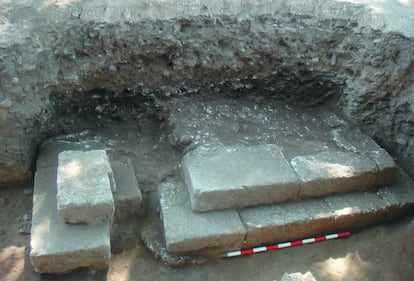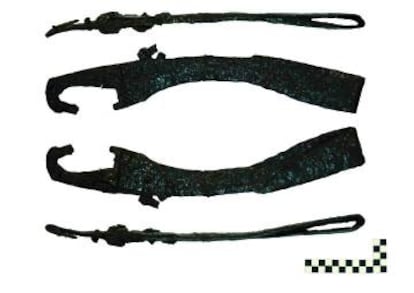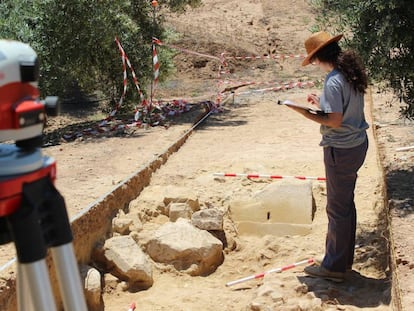Tombs of Iberian prince and 24 aristocrats unearthed in Spain
Experts say these warrior noblemen may have died during the battle that killed famed Carthaginian commander Hamilcar Barca


The general landscape of the Iberian Peninsula in 300 BC consisted of a variety of communities that included the Celts, the Iberians, the Celtiberians and the Lusitanians, while the two main powers of Rome and Carthage fought each other to the death on their turf.
We don’t know what they did with the remains of ordinary people
David Rodríguez González, archeologist
The Carthaginian general Hamilcar Barca invaded Iberia in 235 BC, laying waste to the various communities that he came across. Finally, these groups banded together and waged war on him in what became known as the battle of Heliké – possibly Elche in Alicante or Elche de la Sierra in Albacete – where Hamilcar met his death in 228BC.
Last year, the archeologists and historians María del Rosario García Huerta, Francisco Javier Morales Hervás and David Rodríguez González came to the end of their research after three years excavating and two years analyzing the remains of the Iberian necropolis of Alarcos, in the Spanish province of Ciudad Real, where they unearthed 25 tombs belonging to Iberian aristocrats, including one the experts believe could have belonged to a prince, from the period when Hamilcar was killed in battle.
“We don’t know the exact role of these particular Iberians in the events surrounding the Second Punic War,” says David Rodríguez, a professor of prehistory at Castilla-La Mancha University. “But it is very tempting, although very unlikely, to imagine that they were with the Carthaginians or perhaps they were fighting alongside the Oretani king Orisos in Heliké, a city besieged by Hamilcar which various contingents of Oretani tried to liberate. But it can’t be a coincidence that the majority of the richest tombs in the Alarcos necropolis ascribed to aristocratic warriors are from this precise period or after,” he adds, explaining that this would be between the years 220 and 90 BC.

Two of the 25 tombs belonged to women who were buried along with their weapons and three stand out on account of the quantity and quality of the riches they contain – falcata swords, shields and spears, bits indicating horse ownership and luxurious items made from gold and silver and carnelian quartz, as well as evidence of the sacrifices made upon the death of their occupants. One of the tombs had 453 sheep talus bones, which required the sacrifice of 222 animals, according to experts’ estimates. The bodies of the dead were burned and kept in pots that have been unearthed during the dig.
Another tomb could have belonged to a prince, judging from the massive blocks of stone employed in its construction complete with carved steps, though it was sacked long ago for its valuables. The rest of the tombs have been found to hold 327 objects, nine percent of which were fashioned from gold. Another tomb turned out to be a cenotaph, with no body in it as the warrior apparently died far from the settlement and his remains would have been hard to recover. Yet another contained the grave goods that would have corresponded to an aristocrat and a warrior.
The analysis has shown that there were notable differences among the tombs of the dead which have been classified into three different groups – wealthy, intermediate and simple – though all the belongings indicate an elevated status when compared to those found in different Iberian archeological digs on the peninsula from in the same cultural ambit, according to Rodríguez. What has amazed researchers is the lack of evidence of ordinary folk in the necropolis.

“We don’t know what they did with the remains of these people,” says Rodríguez. “Perhaps they gave them a different kind of burial, such as throwing their bodies in the river, or something like that.” Given that the population would have been over 1,000 over a period of five or six centuries, it is, as Rodríguez points out, a mystery.
The Alarcos site covers 33 hectares and sits on a 100-meter high hill. This, together with other natural defenses such as the Guadiana River, made it a good place to settle permanently. “The Alarcos necropolis has triggered a notable leap in our knowledge of Iberian burials, as we have been able to present a contextualized collection of tombs and materials which allow us to offer a more guaranteed definition of the Iberian burial ritual in general and the Oretani one in particular.”
It is impossible to know for certain whether these warriors killed Hamiilcar, but, according to the Roman historian Appian, we do know how Hamilcar, the father of Hannibal, died. “The Iberian kings killed him in the following manner,” he wrote. “They took carts filled with logs pulled by oxen and these were followed by weapons. On seeing them, the Africans [Carthaginians] burst out laughing. But when they drew closer, the [Oritani] set fire to the carts and hurled them towards the enemy. The fire disconcerted the Africans. Having broken up their ranks, the Iberians killed Hamilcar and a great number of those who were defending him.”
Perhaps the prince in the tomb at Alarcos was the one who designed this successful strategy.
English version by Heather Galloway.
Tu suscripción se está usando en otro dispositivo
¿Quieres añadir otro usuario a tu suscripción?
Si continúas leyendo en este dispositivo, no se podrá leer en el otro.
FlechaTu suscripción se está usando en otro dispositivo y solo puedes acceder a EL PAÍS desde un dispositivo a la vez.
Si quieres compartir tu cuenta, cambia tu suscripción a la modalidad Premium, así podrás añadir otro usuario. Cada uno accederá con su propia cuenta de email, lo que os permitirá personalizar vuestra experiencia en EL PAÍS.
¿Tienes una suscripción de empresa? Accede aquí para contratar más cuentas.
En el caso de no saber quién está usando tu cuenta, te recomendamos cambiar tu contraseña aquí.
Si decides continuar compartiendo tu cuenta, este mensaje se mostrará en tu dispositivo y en el de la otra persona que está usando tu cuenta de forma indefinida, afectando a tu experiencia de lectura. Puedes consultar aquí los términos y condiciones de la suscripción digital.
More information
Archived In
Últimas noticias
A survivor’s account of the Interoceanic Train accident: ‘We were scared because of the speed on the curve’
The Interoceanic Train, the Mexican alternative to the Panama Canal
What is known about the Interoceanic Train derailment in Oaxaca
Trump turns a Minnesota fraud allegation into ammunition for his MAGA army against Democrats
Most viewed
- Oona Chaplin: ‘I told James Cameron that I was living in a treehouse and starting a permaculture project with a friend’
- Reinhard Genzel, Nobel laureate in physics: ‘One-minute videos will never give you the truth’
- Why the price of coffee has skyrocketed: from Brazilian plantations to specialty coffee houses
- Pablo Escobar’s hippos: A serious environmental problem, 40 years on
- Chevy Chase, the beloved comedian who was a monster off camera: ‘Not everyone hated him, just the people who’ve worked with him’










































